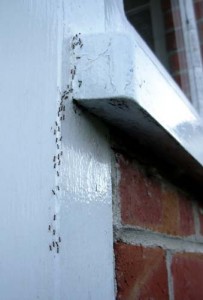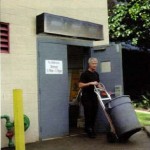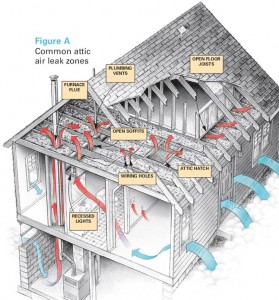 We’ve discussed how looking for light and trying to seal it out will also help keep the bugs at bay. Our next step is a bit more difficult but if we get some understanding of what bugs are looking for we begin to see what draws them into our homes.
We’ve discussed how looking for light and trying to seal it out will also help keep the bugs at bay. Our next step is a bit more difficult but if we get some understanding of what bugs are looking for we begin to see what draws them into our homes.
While air currents can actually deter insects it can also lead them to the Promised Land. Restaurants and warehouses for example use ‘air doors’ on back or bay entries to keep flying bugs out. Also called ‘air dams’ they churn out a powerful blast of air every time the door is open. While it may only muss up your hair or send loosely held papers flying it’s more than enough to shield the entry until the door closes again. Also a well placed box fan will keep German roaches off certain areas in your home (like counter tops). Simply turn it on and point the air to the area you want clear and they’ll leave it alone but that remedy is usually only temporary.
However air is beneficial to bugs in that it’s like a roadmap. Currents of air carry information to them that they can follow to find a mate, food, escape, water, nesting sites or life giving heat. If any of these things lead to your living room then that is where they’ll go. Insects can detect these things from great distances and in very minute amounts. For instance on the colder fall days it’s not unusual to find some of the occasional outdoor roaches inside. How did they know to come in? Simply put they were trying to escape the cold and your home at some point offered warmer air and even showed them how to get in.
to them that they can follow to find a mate, food, escape, water, nesting sites or life giving heat. If any of these things lead to your living room then that is where they’ll go. Insects can detect these things from great distances and in very minute amounts. For instance on the colder fall days it’s not unusual to find some of the occasional outdoor roaches inside. How did they know to come in? Simply put they were trying to escape the cold and your home at some point offered warmer air and even showed them how to get in.
Now for the tricky part, locating air currents or leaks is no easy task. First let me explain about the two types of air leaks you can have. They are ‘wind effect’ and ‘stack effect. Wind effect is more the air that comes into your home from the outside, even while I sit here typing I can feel ‘wind effect’ on my arm coming from the window next to my desk, when my heat kicks on I don’t feel it near as much because of the change in pressure. (It’s cold tonight). To find wind effect leaks it’s best to wait for a windy day or you can create the wind with a partner outside pointing a leaf blower towards the areas you’re checking. Then turn off your air system, which will depressurize the home. Choose either a tissue draped over a hanger, an incense stick or even a candle. Move through the home placing your device over windows, door frames, and electric sockets, plumbing areas that exit the home, dryer vent pipes, cracks or seams in drywall or trim. Fluttering paper or flickering flame indicates wind effect. Much like our search for light, you’ll need to seal those areas up.
 Stack effect is inside to out and more difficult to find. It’s caused by warm air rising through the house. It may leak out in hard to follow paths through cracks or gaps then into the interior walls and finally up and out of the attic. In any event if it exits the house you have stack effect. In the basement / crawl look for cracks in the foundation or gaps in the bricks, basement windows are usually a prime source. Plumbing pipes, electrical or cable lines that are not sealed will also allow for air leaks. In the living areas check recessed lighting, gaps in trim, the chimney area that meets the ceiling and any areas similar to your wind effect check list. In the attic look at vent pipes that come up through the ceiling or any other plumbing areas, also un capped wall voids are huge contributors. No tissues on a stick here it’s more inspect and seal. Of note you can have a blower door test done which will detect many leaks however I have a hunch it’s kind of costly.
Stack effect is inside to out and more difficult to find. It’s caused by warm air rising through the house. It may leak out in hard to follow paths through cracks or gaps then into the interior walls and finally up and out of the attic. In any event if it exits the house you have stack effect. In the basement / crawl look for cracks in the foundation or gaps in the bricks, basement windows are usually a prime source. Plumbing pipes, electrical or cable lines that are not sealed will also allow for air leaks. In the living areas check recessed lighting, gaps in trim, the chimney area that meets the ceiling and any areas similar to your wind effect check list. In the attic look at vent pipes that come up through the ceiling or any other plumbing areas, also un capped wall voids are huge contributors. No tissues on a stick here it’s more inspect and seal. Of note you can have a blower door test done which will detect many leaks however I have a hunch it’s kind of costly.
So there you have it, just another taste of how and why insects enter the home. If you know of anything I’ve missed please let us know. It always amazes me when I learn of new ways of insect survival and I almost always learn from others experiences. We’ll pick up on our pest proofing series again real soon, perhaps from something you’ve shared.




